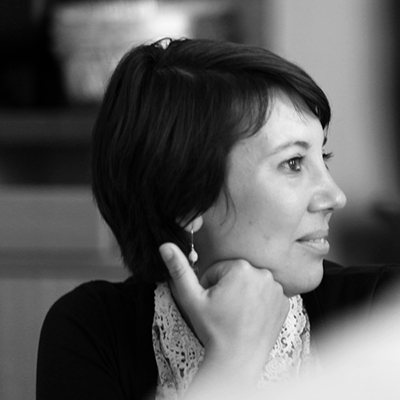As the DOORS team is adding finishing touches to the agenda of the first stage of the incubator, we turned to one of our jury members to find out what the selection of the participating institutions brought to light. We wanted to share the invaluable lessons learnt so far with those for whom DOORS will be a stepping stone, those whose ideas did not make it into this programme but should be pursued nonetheless, and those just preparing to take the digital leap.

Julie Becker is a freelance facilitator and museographer. Over the years, she worked for two national museums in the UK and Belgium, an exhibition design agency, and the European Science Engagement Network (Ecsite). She believes the museum sector can offer empowering experiences that inspire visitors to shape a fairer, more sustainable world. These days, Julie can be delivering online professional workshops, developing an app for a botanical garden, helping cultural organisations with strategic processes, and assessing applications.
I am sure you get asked this a lot, but what are the biggest challenges the sector faces in terms of digitalisation. What impact can projects like DOORS have, and why are they necessary?
Julie Becker: My response will be slightly biased because the section of the sector that we got to see through DOORS is made up of organisations that are willing and ready to work with digital. Still, one thing that struck me was that the challenge isn’t convincing museums to take notice or engage with digital. There’s a readiness level that wasn’t 10 or 15 years ago.
I would say that, especially for medium-sized or small museums that applied for the incubator, the challenges now are issues such as budgets – digital tools can be expensive, skills – museum workers either don’t have or find it difficult to acquire the necessary skills. As a result of the lack of skills – and we saw this several times in applications – despite organisations or staff being aware they need to do something with digital, they rush into ideas, solutions, or even gadgets without a rationale for why they’re doing it. Instead, there needs to be an alignment with organisations’ strategic goals that begins with questions like why we do digital, what it is that it allows us to deliver, and how it enables us to carry out our mission. For instance, we’ve seen projects that aim to innovate audience engagement, rushing to use technology based on the assumption that people will be enthusiastic about it without considering the audience’s needs. This brings about the risk of digital being used with a top-down broadcasting approach, where museums deliver narratives or experiences without thinking about their audiences.
What do you think projects like DOORS should focus on to help museums overcome these challenges?
Julie Becker: What is great about incubation processes or prototyping is that there is permission to get it wrong, experiment, and take risks. I’m convinced it can help organisations who are eager to try but don’t know why or how and, at the same time, realise they need to think about the why or how before they jump to solutions. I love this idea of permission to fail. I would love it if some projects concluded that their idea didn’t work, but they have learnt a lot in the process. I think the incubator will help organisations take their first steps or go a little bit further without jeopardising their core mission or core funding. At the same time, some of the projects selected are quite mature, their scope is quite clear, and I believe they will be able to make a relatively small amount of money go a long way. I think those can become beautifully crafted little jewels.
Some of the proposals I thought were lovely—for instance, the project of the National Library of Romania. Thanks to the incubator, they will be able to digitise 70s pieces of vinyl in their collection and instal a nice listening corner in the library. This was an example of a strong rationale for digitising a collection at risk. That would have been enough for the piloting stage, but they also thought about their audiences and found an excellent way to add a physical component to the project. It’s simple but well-thought-out.
Did anything surprising or unexpected come to light as you went through the applications? Did you learn anything new about the sector from reading these proposals?
Julie Becker: I’ve already touched on the eagerness to embrace digital, but this is only a sample. Besides that, I was surprised by how many organisations didn’t consider their audiences. For me, asking why your visitor might want to do or see something is the basis of everything. Another surprise, this time a pleasant one, was the fact that many organisations used the disruptive pandemic times for pilots. I assume they had permission to try things they otherwise wouldn’t have been allowed. It was lovely to see quite a few applications leveraging what they learned during COVID to take the next step. In a way, the pandemic seems to have also had a positive impact on the sector; it seems to have provided some organisations with short incubation stages. People tried things and accepted that they weren’t perfect, which gave them more freedom to innovate and improvise.
I don’t know if it’s a surprise, but I particularly liked the applications that tried to develop new revenue models. I thought some of them were very clever. For instance, The Museum of Literature Ireland will purchase equipment for a studio to produce their own digital content, but they will also offer it for hire at a low cost. That’s a clever way to make some money and provide a service to the community. The same goes for the Museum of Urban Wooden Architecture which aims to service a community while generating revenue from selling parts they get from houses about to be destroyed. I particularly liked that it widens the scope and aim of a museum.
.
Going back to what you said about the need to consider audiences, in very practical terms, how can museums respond to their audiences better? What are the best ways to reach them, engage with them, and use their feedback?
Julie Becker: I believe museum professionals who would typically take audiences into account in areas where they feel more comfortable – for instance, exhibition-making – lose their good reflexes when faced with the unknown of the digital. If your organisation is already audience-centric, don’t lose that when faced with digital; keep working with audiences for that as well. I’ve seen a few times how organisations lose their good practices when faced with a new thing.
Besides that, obvious things like market research, focus groups and working with your communities are a great start. It can seem overwhelming if you’re not used to working with your audiences. Still, you can start with small projects that can help you understand the potential of interacting with audiences and communities of interest.
Do you have any general tips for museum practitioners who find digital integration intimidating or overwhelming. How can they approach the mind shift towards digital?
Julie Becker: Without the skills or knowledge in your organisation, it is hard to start independently. That’s why getting external help, whether companies or consultants, is the best way to start. Similarly, applying for projects like this one or accessing national or regional resources intended to help the cultural sector transition can be a great springboard.
And when they do decide to start, my first advice would be to start small because it is much easier to experiment on a small scale and, of course, less intimidating. And, going back to what I was saying earlier, think about questions like why you feel you need anything digital and in which aspect of your practice. This means viewing digital as not a thing on its own but as a tool that you use to achieve something. That way, you stick to your vision, mission or existing strategy, and digital is simply one of the tools that help deliver that, making it less intimidating.
For those considering embedding digital into their strategy, in your opinion, what do they need to consider first and foremost to ensure a sustainable digital transformation and not just a one-off project?
Julie Becker: Skills are the starting point. If your workforce does not have the right skills, it will be difficult to sustain any digital endeavour.
I also think it’s essential not to get too enthusiastic about one technology or software. For instance, AR is mentioned a lot in the proposals, and we had a suspicion that it was because it’s fashionable. There didn’t always seem to be an understanding of or a reflection on the value of AR. My advice is to think about your aim and then about specific technologies that can add value to it. I would also say museums should minimise, as much as possible, investments into hardware or software because they are transient, and their maintenance or update costs might be hard to sustain.
Can you give us an example of a digital pilot that you’ve seen implemented or an online programme you attended and thought was great?
Julie Becker: There are many great examples out there, and they’re not all from huge organisations with in-house teams. Let me share the first one that comes to my mind – probably because I enjoyed it a lot as a (remote) visitor. The escape game designed by Navet Science Centre in Borås, Sweden, during the pandemic is an excellent example of low tech, inexpensive solution. In the virtual exhibition space – created with 360-degree photography of their space – you had to look for clues to solve riddles. Most of the time, to solve the riddle, you were taken out of the 360-viewing platform to a simple google form or a PowerPoint slide etc. It looked and felt like a prototype but what was great about it was that they permitted themselves to do it relatively low tech by combining different tools already out there. And it worked. Because it had been done by the museum staff who knew their collection well, it nicely tied in with the content. I loved it because, while it wasn’t technologically perfect, it was a nicely engineered visitor experience. This example shows that if you understand the needs & motivations of your audience and create excellent content in response to that, you don’t need to use crazy technology to get started.
Any thoughts you’d like to share with us at the end?
Julie Becker: One of the most exciting things was seeing so many proposals from Central Europe and Eastern Europe. It was heart-warming to see that these projects can help regions with the will but not yet the means to go one step further.



